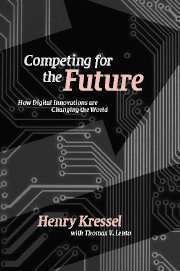Book contents
- Frontmatter
- Contents
- List of figures
- List of tables
- Acknowledgements
- Introduction
- Part I The technology – how electronic devices work – digital systems and software
- Part II Innovators, entrepreneurs, and venture capitalists
- Part III Global reach, global repercussions
- Appendix 1.1 Smaller, faster, more efficient MOSFETs
- Appendix 1.2 Building multi-transistor logic gates
- Appendix 1.3 MOSFETs in memory devices
- Appendix 1.4 CMOS reduces logic gate power dissipation
- Appendix 1.5 Laser diode basics
- Appendix 1.6 Light-emitting diodes (LEDs)
- Appendix 1.7 Photodetectors
- Appendix 1.8 Making fiber optic cables
- Appendix 1.9 Principles of LCD displays
- Appendix 2.1 The demise of analog computers
- Appendix 2.2 IP, TCP, and the Internet
- Appendix 2.3 Building an object-oriented program
- Index
Appendix 2.2 - IP, TCP, and the Internet
Published online by Cambridge University Press: 07 December 2009
- Frontmatter
- Contents
- List of figures
- List of tables
- Acknowledgements
- Introduction
- Part I The technology – how electronic devices work – digital systems and software
- Part II Innovators, entrepreneurs, and venture capitalists
- Part III Global reach, global repercussions
- Appendix 1.1 Smaller, faster, more efficient MOSFETs
- Appendix 1.2 Building multi-transistor logic gates
- Appendix 1.3 MOSFETs in memory devices
- Appendix 1.4 CMOS reduces logic gate power dissipation
- Appendix 1.5 Laser diode basics
- Appendix 1.6 Light-emitting diodes (LEDs)
- Appendix 1.7 Photodetectors
- Appendix 1.8 Making fiber optic cables
- Appendix 1.9 Principles of LCD displays
- Appendix 2.1 The demise of analog computers
- Appendix 2.2 IP, TCP, and the Internet
- Appendix 2.3 Building an object-oriented program
- Index
Summary
We already know that special computers called routers direct data traffic on a packet-switched network, and that computers communicate through special, industry-defined machine languages (protocols). Here we examine the protocols that underlie packet networks in general and the Internet in particular.
The protocol that has reached star status for communications systems is the Internet Protocol (IP), which grew out of the early ARPANET work. Networks designed to operate with the IP protocol use a 32-bit address embedded in each packet header to move it from source to destination.
Every computer on the Internet has an IP address. That includes each router. Since routers transmit digital streams of bits in the form of packets, the physical implementation of the IP protocol involves coding headers attached to the packets. These headers provide the address of the sending and receiving computers.
The packets travel a path from one router to another on the way to their destination. The routers direct this trip, using stored lookup tables to find paths to the destination IP address in the packet headers.
But even IP doesn't work alone. To provide reliable internetworking on the Internet, it is closely linked with TCP (Transmission Control Protocol). Let us look at how IP and TCP work together.
While the router lookup tables are continuously updated, that doesn't prevent packets from getting lost or delayed. If a target router is temporarily overloaded or down, the packets sent through it could lose their way, and the network would be unreliable.
- Type
- Chapter
- Information
- Competing for the FutureHow Digital Innovations are Changing the World, pp. 381 - 382Publisher: Cambridge University PressPrint publication year: 2007



